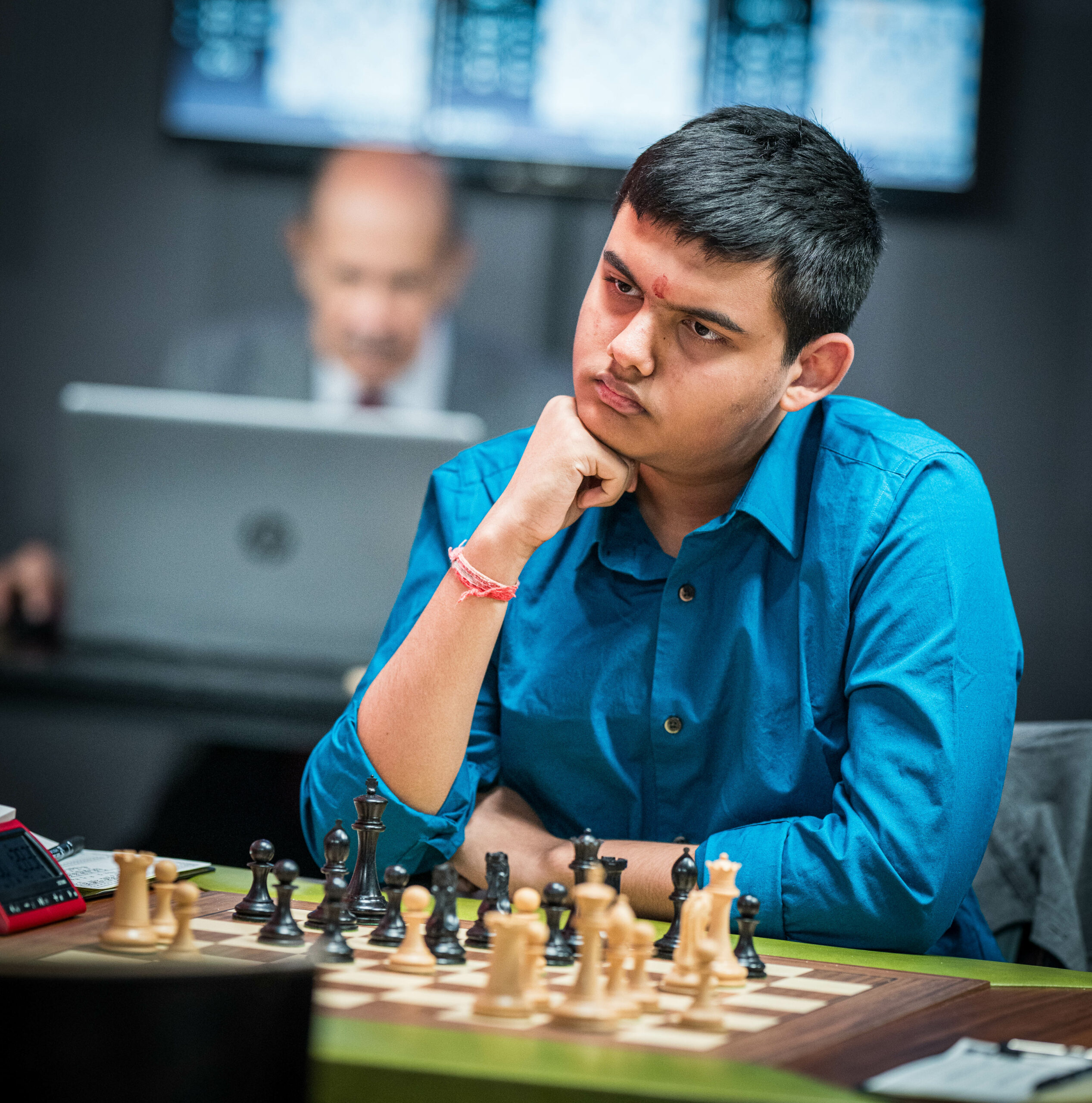Toms River Chess Club Newsletter 2017 #7
This week (23 February-2 March)….
A new era has begun! The champion of the Toms River Chess Club will be crowned at this week’s meeting! Edd Knowles will receive the rotating trophy proclaiming him “Club Champion”! Having previously been “Ocean County Champion” and having won the “Fall Open”, Edd becomes “Club Champion” for the first time in his long chess career! Among many accomplishments, he once beat Samuel Reshevsky and drew Viktor Korchnoi! Unfortunately, he lost to Bobby Fischer! He will play a simul against any takers at the meeting to begin his reign. This may have been the first confirmed club championship since 1998!
After a long (5 rounds) and hard played tournament, Edd prevailed! The final game, to determine the champion, against Rob Slomicz, was pivotal; if Rob won, he would tie for the lead with Pat Balton, necessitating a playoff. The score was 4 points for Edd and 3 ½ for Rob. Rob had the white pieces and opened with his preferred Reti: Nf3. The game (annotated prodigiously by the champion):
”This was the last round of the Toms River Chess Club Championship. My opponent, Ron Slomicz has always been a difficult opponent for me but I was glad to be playing the Black pieces as I, like Fischer, have always been an advocate of Obender’s move (1 e4 )* , but Rob plays the Accelerated Dragon variation of the Sicilian very well, and it’s the only variation of the Sicilian that I have trouble with. As White, Rob plays the Reti ( 1 Nf3) which can transpose into almost any opening, but I figured he’d play it safe and fianchetto his King’s bishop, in which case I’d be happy to play a Reverse Samaisch King’s Indian…
1 Nf3 c5
2 e4 !? …
Surprise ! Rob transposes into a Sicilian Defence, which I like playing either side of any variation (except the White Side against the Accelerated Dragon). I feel that this was a competitive mistake on Rob’s part. This is a sudden death time limit, and I can just rattle off the opening moves from memory, giving me a not insignificant time advantage.
2… d6
My favorite Najdorf. I almost never play anything else (…e6, …Nc6, …Nf6)
3 d4 cd
4 Nd4 Nf6
5 Nc3 a6
6 Bg5 ….
White had a lot of options: Bc4, Be3, f4, Be2, h3, f3. Bg5 is the Richter-Rauzer attack, one of the most popular of White setups.
6 …. e6
7 f4 Be7
8 Qf3!? ….
I could hardly believe it! Rob was daring me to play the infamous Gothenburg Variation. He had beaten me in an offhand game, but he knows that I know this variation, so I thought that it was pretty ballsy of him to play it against me in a tournament game.
8 … h6
9 Bh4 g5!
I accept the challenge! This is a positional pawn sacrifice. The idea is to post a knight on e5 where it dominates the position. In order for White to develop an initiative he’s almost forced to sac a piece. It’s very complex and has been worked out to be a draw (which is all I needed to win the championship), which is another reason I thought it was a strange choice for Rob…
10 fg Nfd7
11 Ne6! fe
12 Qh5+ Kf8
13 Bb5! Ne5??
The first question mark is because this move is a mistake, the second question mark is for the fact that I very well knew what the correct move was (Rh7 !!, discovered by Bobby Fischer in 1958). At the Gotheburg Oympiad 1955 when the Argentinians Panno, Pilnik and Najdorf all played this variation against the Russians Geller, Spassky and Keres, they all lost!! Pilnik and Najdorf played 13…Kg7, while Panno played “my” 13…Ne5. In 1958 at the Potoroz tournament Fischer found 13…Rh7. I had mentioned Rh7 to Rob when I had lost to him in this variation, which is all the more puzzling that I again forgot to play it. Ne5 is consistent and looks logical (covering all the light squares around the king), and the position is very complex, so meeting this over the board without having seen Geller’s refutation beforehand is problematic… The bishop for the moment is untouchable: 13..ab 14 0-0+ 15 Bf6 (K moves, Qf7 mate) and Black is lost. The point of the bishop move is that it inhibits Black’s establishment of the knight on e5, since if Black plays his queen knight to d7 to reinforce the other knight, White can just exchange it. Since the whole point of the variation is to fix a knight on e5, Bb5 almost refutes the variation (which is probably what the Russians thought in 1955).
14 Rf1+ ? ….
The right move is 14 Bg3!
14… Kg8
15 Be8 ?? ….Rob took a long time to come up with this lemon. It just loses a piece. See the note to move 13; this bishop needs to exchange itself for a knight at some point…
15 ……hg !
Both of Whites Bishops and his Queen are attacked.
16 Qe2 Qe8
Perhaps I should have taken the other bishop, but in either case Black is 2 pieces up (!) and White’s attack has been repulsed. The game is over. I should’ve just consolidated and simplified. Rob knows me well though, so he keeps playing J
17 Bg3 Nbc6
18 0-0-0 Qh5
19 Qf2 Bd7
20 Qb6 Kg7!
Black connects his rooks and thereby completes his development. White can’t really take the b7 pawn as it would only open the b-file for Black to attack the White king.
21 Kb1 Rhc8?!
I decided to launch an attack on the queenside, but it was better to challenge the f-file and maybe exchange rooks. I should have been just looking to exchange down to an endgame where I’d have 2 pieces and Rob would have nothing…
22 Qe3 Nc4
23 Qd3 N6e5
24 Qd4 Bf6
25 h3! ….
I completely missed the point of this move. White takes away the g4 square so that Black can’t answer Qf2 with Ng4.
25 …. Nb2 ??
This “brilliant” move is a blunder that loses material and the initiative. Black’s position looks overwhelming, but in reality his king his still vulnerable
26 Qf2! …..
Of course not 26 Kb2 Nc4+ wins the queen. Now I panicked. White is attacking d6(pawn) and f6(bishop), and his bishop on g3 is poised to exchange the knight on e5 which is the main defender of the king…
26 ….Nf3?!
It’s actually impressive how many pieces I was able to place under attack simultaneously. The intent of Nc3 is to force the closing of the f-file, exchange some pieces and hopefully not give back so much material that I can’t avoid losing before Rob ran out of time (he only had a few minutes left on his clock at this point, while I had almost an half hour…).
27 Rd6 ….
Adding the Black Queen Bishop to the number of pieces I have under attack.
27 … Rc7
28 e5!? …
Now every single one of my minor pieces is under attack. Luckily, only one piece can be taken per move…
28 … Be7
The position is very complicated. The best thing I can say about my play since move 17, when I was 2 pieces up, was that it confused the issue enough that after I messed the position up, Rob didn’t have enough time to figure out how to win…
29 Kb2 Bd6
30 ed Rc4!
31 gf Rac8
After Black’s orgy of self-destruction, he still is an exchange up and the f-file has been blocked (at least temporarily).
32 Be5+! …
Rob is still fighting!
32 … Kg8
33 f4! Qh4!
34 Qd2 R1c5
35 Qd3 Qh7
36 Qg3 Qf5!
This is probably the winning move after so many “adventures”. The f-pawn is pinned and white doesn’t have time to find an invasion route. Also, Rob was in severe time trouble…
37 Rf2 b5!
38 Qf3 b4
39 Qh5 bc+
40 Ka1 Re5!!
Boom! This finally ends the nonsense. For a moment I got worried that I had made another “brilliant blunder”, as 41 fe Qf2? 42 Qg5+ is not at all clear (can Black escape perpetual check?). My original intention was 41 fe Re4 !? (when capturing the queen allows Re1 mating) but then 42 a3 again seems problematic… But really after 41 fe Rf4! 42 Rf4 gf! 43 Qf5 ef is an easily won ending. I had enough time on my clock (almost 20 minutes) to figure this out, but I didn’t have to because Rob resigned, allowing me to pretend that I had seen everything J.
* Legend has it that O’Bender was an extremely weak chess player who nevertheless convinced the people on an island to pay him in advance for a simul. Obender opened with 1 e4 on every board and lost every game, but escaped by boat from the island before the islanders could get a “refund”.”
The tournament (although unrated) was a huge success for the TRCC. Some members were playing in their first tournament, others were inspired to join the USCF and play in money tournaments. Everyone embraced and enjoyed the event enthusiastically! The final standings were: Edd Knowles – 5, Pat Balton 41/2, Greg Coats – 4, Rob Slomicz – 31/2, Jonathan Capalbo, Kyle Garrison, Kyril Kavetsky, Bob Whiteside, Andrew Assur, Jim Tuzeneu, Dan Balton and Isaiah Hamilton – 3, Jim Bonanno and Isaiah Totaro, 21/2, Paul Howe, Evan Segui, Alicia Baylock, Bob Capalbo and Matthew Gil – 2, Dylan Clark, Ray Hanrahan, Stan Laychick and Janice Kenny – 11/2, Mike Symczak – 1, and Chris Kenny – 0. House players were Joan Totaro and Steve D’Agostino. Congratulations and thanks to all participants! Come to the meeting and play Edd in a simul! See him receive the Club Championship trophy! Other prizes and awards will be given!
Also attending the meeting were: Lowell Berg, Reah Hamilton, Joseph O’Brien, Rob Murray (keeping a close eye on the Knowles-Slomicz game), Pat Festa, William Wright, Mike Favata and Damon Simms. Pat continued his lessons with Reah, who played and impressed Lowell with her play and level of skill. All agree that Reah could be quite good in the future!
Don’t forget the GM Fabiano Caruana lecture and simul at OCC on Saturday. Come early to the library to honor Steve Doyle. Check out the Asbury Park Press for an article about the simul. I am not sure when it will run.
And Isaiah Hamilton will be celebrating his birthday at the meeting this week. Prepare to sing “Happy Birthday”!
Any questions or comments, contact me,
Stephen Shoshin
732-598-8125

